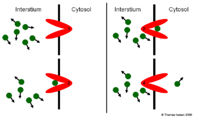Difference between revisions of "Transport Proteins - Physiology"
| Line 8: | Line 8: | ||
<br> | <br> | ||
| − | == | + | |
| + | ==Diffusion Through Water Filled Protein Channels== | ||
| + | |||
| + | Hydrophillic ions and molecules are unable to diffuse across the lipid bilayer. However if concentration gradients allow it they are sometimes able to diffuse across the membrane using water filled protein channels. These tend to be only large enough for small ions to pass through and so are perhaps more commonly known as '''ion channels'''. As well as concentration gradients, electrical gradients can cause the movement of ions. They tend to move towards areas of the charge opposite to themselves. The two factors of concentration and electrical are termed collectively as the electrochemical gradient and it is their combined effect which determines the movement of ions through channels. As the ions are moving down gradients this method of membrane transport is '''passive'''. The channels are usually specific to one or a few ions and can be opened and closed by the cell depending on what process ions are required for. | ||
| + | |||
| + | ==Facilitated Diffusion== | ||
[[Image:facildiftri.jpg|right|thumb|200px|<small><center>Schematic of a Transport Protein</center></small>]] | [[Image:facildiftri.jpg|right|thumb|200px|<small><center>Schematic of a Transport Protein</center></small>]] | ||
| − | Transport proteins allow hydrophillic molecules, which are too large to get through water filled protein channels, to passively cross the membrane. The molecules bind to protein and then the protein changes shape depositing the molecule at the other side of the membrane. This transport method is also known as '''Facilitated Diffusion'''. As with diffusion it occurs from areas of high concentration to those of low. | + | Transport proteins allow hydrophillic molecules, which are too large to get through water filled protein channels, to passively cross the membrane. The molecules bind to protein and then the protein changes shape depositing the molecule at the other side of the membrane. This transport method is also known as '''Facilitated Diffusion'''. As with diffusion it occurs from areas of high concentration to those of low so is a '''passive''' process. |
| − | ==Differances Compared to Diffusion== | + | ===Differances Compared to Diffusion=== |
* The proteins are very specific to very few molecules | * The proteins are very specific to very few molecules | ||
| Line 18: | Line 23: | ||
* Some of the proteins bind a small number of differant molecules. These molecules will compete for the proteins and will be transported in similar relative quantites to their original concentrations. | * Some of the proteins bind a small number of differant molecules. These molecules will compete for the proteins and will be transported in similar relative quantites to their original concentrations. | ||
| − | == | + | ==Co-Transporters== |
| − | + | This family of membrane proteins are involved in [[Active Transport - Physiology#Secondary Active Transport|Secondary Active Transport]]. They bind two molecules and transport them accross the membrane either in the same direction ('''symporter''') or in opposite directions ('''antiporter'''). the [[Active Transport - Physiology#Development of Potential Energy|potential energy]] derived from forcing one molecule across this allows the other cotransported molecule to be transported against its gradient. | |
==More Information== | ==More Information== | ||
If more information on Facilitated Diffusion is need it can be found [http://en.wikipedia.org/wiki/Passive_diffusion here] | If more information on Facilitated Diffusion is need it can be found [http://en.wikipedia.org/wiki/Passive_diffusion here] | ||
Revision as of 13:48, 15 August 2008
|
|
Diffusion Through Water Filled Protein Channels
Hydrophillic ions and molecules are unable to diffuse across the lipid bilayer. However if concentration gradients allow it they are sometimes able to diffuse across the membrane using water filled protein channels. These tend to be only large enough for small ions to pass through and so are perhaps more commonly known as ion channels. As well as concentration gradients, electrical gradients can cause the movement of ions. They tend to move towards areas of the charge opposite to themselves. The two factors of concentration and electrical are termed collectively as the electrochemical gradient and it is their combined effect which determines the movement of ions through channels. As the ions are moving down gradients this method of membrane transport is passive. The channels are usually specific to one or a few ions and can be opened and closed by the cell depending on what process ions are required for.
Facilitated Diffusion
Transport proteins allow hydrophillic molecules, which are too large to get through water filled protein channels, to passively cross the membrane. The molecules bind to protein and then the protein changes shape depositing the molecule at the other side of the membrane. This transport method is also known as Facilitated Diffusion. As with diffusion it occurs from areas of high concentration to those of low so is a passive process.
Differances Compared to Diffusion
- The proteins are very specific to very few molecules
- The proteins have a maximal rate. If the concentration of the molecule to be transported is very high the number of proteins is likely to limit the rate.
- Some of the proteins bind a small number of differant molecules. These molecules will compete for the proteins and will be transported in similar relative quantites to their original concentrations.
Co-Transporters
This family of membrane proteins are involved in Secondary Active Transport. They bind two molecules and transport them accross the membrane either in the same direction (symporter) or in opposite directions (antiporter). the potential energy derived from forcing one molecule across this allows the other cotransported molecule to be transported against its gradient.
More Information
If more information on Facilitated Diffusion is need it can be found here
